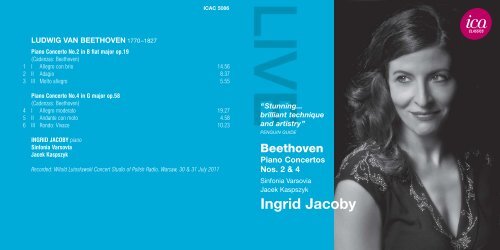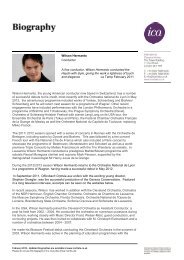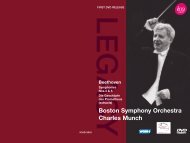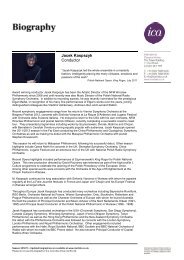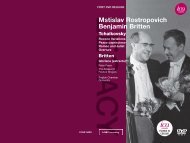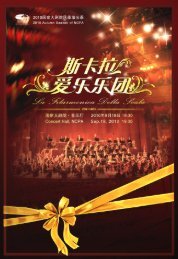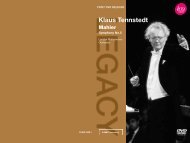Ingrid Jacoby - International Classical Artists
Ingrid Jacoby - International Classical Artists
Ingrid Jacoby - International Classical Artists
Create successful ePaper yourself
Turn your PDF publications into a flip-book with our unique Google optimized e-Paper software.
ICAC 5086<br />
LUDWIG VAN BEETHOVEN 1770–1827<br />
Piano Concerto No.2 in B flat major op.19<br />
(Cadenzas: Beethoven)<br />
1 I Allegro con brio 14.56<br />
2 II Adagio 8.37<br />
3 III Molto allegro 5.55<br />
Piano Concerto No.4 in G major op.58<br />
(Cadenzas: Beethoven)<br />
4 I Allegro moderato 19.27<br />
5 II Andante con moto 4.58<br />
6 III Rondo: Vivace 10.23<br />
INGRID JACOBY piano<br />
Sinfonia Varsovia<br />
Jacek Kaspszyk<br />
Recorded: Witold Lutosl awski Concert Studio of Polish Radio, Warsaw, 30 & 31 July 2011<br />
/<br />
“Stunning...<br />
brilliant technique<br />
and artistry”<br />
PENGUIN GUIDE<br />
Beethoven<br />
Piano Concertos<br />
Nos. 2 & 4<br />
Sinfonia Varsovia<br />
Jacek Kaspszyk<br />
<strong>Ingrid</strong> <strong>Jacoby</strong>
INGRID JACOBY PLAYS BEETHOVEN’S<br />
PIANO CONCERTOS NOS. 2 & 4<br />
Early in 1801 Beethoven offered his B flat Piano Concerto<br />
for sale to the Leipzig publisher Hoffmeister at the<br />
knockdown rate of ten ducats, ‘because I do not regard it<br />
as one of my best’. To us the concerto seems a youthful<br />
charmer, saturated with the spirit of Haydn and Mozart but<br />
teeming with original ideas and, in the rondo finale,<br />
Beethoven’s own brand of humour. ‘Underrated, delightful<br />
and full of life’, is <strong>Ingrid</strong> <strong>Jacoby</strong>’s verdict. Yet by 1801<br />
Beethoven doubtless considered it old-fashioned:<br />
unsurprisingly, since he had begun the work back in 1788,<br />
completed a first version during the winter of 1794–5, and<br />
then revised it after giving the public premiere in 1795.<br />
True to form, though, he only wrote out the piano part just<br />
before it was published, as No.2, in 1801. Until then he<br />
had played it from memory, thereby ensuring that no rival<br />
could ‘steal’ the concerto.<br />
The concerto’s opening – a brusque summons followed<br />
by a pleading response – is an arresting take on a favourite<br />
Mozartian gambit. But later, where Mozart would have<br />
introduced a new tune, Beethoven plunges into the remote<br />
key of D flat to develop the main theme’s beseeching<br />
answering phrase. This surprise move to D flat has<br />
consequences when the soloist later introduces a<br />
mysterious new theme in this key – an early example of<br />
Beethoven’s concern for long-range tonal planning. ‘He’s<br />
taking lessons from Mozart here’, says <strong>Ingrid</strong> <strong>Jacoby</strong>. ‘But<br />
the movement is pure Beethoven: more modern in feeling,<br />
that much denser and more brilliant in its piano textures.<br />
And the huge cadenza, written much later, in 1809, is as<br />
un-Mozartian as you can get. It even has elements of the<br />
late sonatas: the fugal beginning, the use of the keyboard’s<br />
extremes, and the way it develops the themes.’<br />
2<br />
The noble theme of the E flat Adagio, somewhere<br />
between an aria and a hymn, has that exalted simplicity<br />
typical of Beethoven’s early slow movements. Equally<br />
typically, Beethoven then embellishes this melody with<br />
increasingly lavish figuration, just as an operatic heroine<br />
would decorate a slow cantilena; and we can be sure that<br />
he improvised these embellishments differently each time<br />
he played the concerto. Adds <strong>Jacoby</strong>: ‘With its rich<br />
textures and suspensions this Adagio is typical of<br />
Beethoven’s early slow movements. And at the end, we<br />
have an amazing, highly emotional recitative, marked con<br />
gran espressione and enhanced by the resonance of the<br />
sustaining pedal. Here, more than anywhere, Beethoven<br />
goes into his own sound world.’<br />
Mozart liked to end his B flat concertos with huntingstyle<br />
rondos in 6/8 time. Beethoven’s finale follows suit,<br />
though he adds his own subversive twist by peppering his<br />
catchy main theme with offbeat accents. There are more<br />
rhythmic dislocations in the central episode, where the<br />
theme is treated to boogie-like syncopations. ‘It’s<br />
Beethoven at his most boisterously humorous,’ says<br />
<strong>Jacoby</strong>. ‘The theme is so simple, yet in this middle section<br />
he enjoys poking fun at it with all those syncopations and<br />
harmonic dissonances.’ Perhaps the wittiest stroke comes<br />
in the coda where the piano slips nonchalantly into G<br />
major for a smoothed-out version of the rondo theme<br />
before the orchestra noisily intervenes with the tune in its<br />
original, unruly form.<br />
Beethoven’s so-called middle period – corresponding<br />
roughly to the decade from 1803 – is famously associated<br />
with the notion of heroic struggle. But the image of the<br />
furrow-browed Titan forging mighty, dynamic structures<br />
is far from the whole picture. Just as characteristic are<br />
works where the expanded scale of Beethoven’s thinking<br />
goes hand in hand with a new lyric breadth and tranquillity:<br />
the ‘Pastoral’ Symphony, the Violin Concerto and the<br />
Fourth Piano Concerto, in their way just as revolutionary<br />
as the ethically charged strivings of the ‘Eroica’ and<br />
Fifth Symphonies.<br />
After making brief sketches in 1804, Beethoven turned<br />
to the G major Concerto in earnest during 1806, when<br />
the Fifth Symphony was also on the stocks; and it is surely<br />
no coincidence that their first movements view the same<br />
four-note figure from a drastically different perspective. As<br />
<strong>Jacoby</strong> puts it: ‘In the symphony Beethoven compresses<br />
and contracts. In the concerto he does the opposite,<br />
and serenely expands the opening motif.’ The composer<br />
himself gave the public premiere in his gargantuan benefit<br />
concert in Vienna’s Theater an der Wien on 22 December<br />
1808 that also included the first performances of the<br />
‘Pastoral’ and Fifth Symphonies, parts of the Mass in C<br />
and the Choral Fantasy. Reports of the concert are scant,<br />
though the composer J.G. Reichardt, who was present in<br />
the freezing theatre, noted ‘a new fortepiano concerto of<br />
monstrous difficulty, which Beethoven played astonishingly<br />
well at the fastest possible speeds’.<br />
The concerto begins, unprecedentedly, with an<br />
exquisitely gentle theme for the soloist alone, richly<br />
scored in the keyboard’s resonant middle register. ‘While<br />
it sounds simple, this poetic opening is deceptively<br />
difficult,’ says <strong>Jacoby</strong>. ‘It demands perfect control of<br />
sound, the most precise balancing of chords. It reminds<br />
me of Schnabel’s remark that great music is greater than<br />
it can ever be played.’<br />
Although the movement has its bouts of virtuoso<br />
brilliance, as that first reviewer suggested, the predominant<br />
tone is one of confiding tenderness. Time and again<br />
the piano quietly deflects the orchestra’s propensity<br />
to vigorous assertion, with prepared climaxes tending<br />
to dissolve into lyrical meditation. At the end of the<br />
3<br />
exposition, for instance, a long trill leads us to expect a<br />
rousing orchestral tutti. But Beethoven foils expectations in<br />
a haunting passage where the soloist muses quietly on a<br />
cadential theme first heard in the orchestral introduction.<br />
The piano likewise takes the role of gentle appeaser in<br />
the theatrically conceived Andante con moto. Beethoven’s<br />
nineteenth-century biographer A.B. Marx aptly compared<br />
this movement to Orpheus’s taming of the Furies. It can<br />
also be heard as the confrontation of two musical worlds:<br />
Baroque rigour in the strings’ brusque unisons, in dotted<br />
rhythm (the first phrase could have stepped from a tragic<br />
Handelian scena), Romantic pathos in the keyboard’s soft<br />
harmonised responses. ‘Beethoven stipulates the una<br />
corda, or soft, pedal until near the end,’ observes <strong>Jacoby</strong>,<br />
‘which gives the music a wonderful veiled quality.’<br />
Gradually the orchestra’s harshness is quelled by the<br />
piano’s increasingly eloquent pleas. Finally, the keyboard<br />
asserts its pre-eminence in an impassioned cadenza-like<br />
climax, with a fortissimo sustained trill, before the dotted<br />
rhythms are reduced to a ghostly whisper in the bass.<br />
The Andante barely leaves the key of E minor. The<br />
Rondo, which enters softly without a break, re-establishes<br />
G major via several bars of C major: the kind of witty<br />
off-key opening Beethoven learned from Haydn. For all<br />
its swagger and playfulness, this finale shares the first<br />
movement’s core of rich, tranquil lyricism: in the dolce<br />
second theme, announced by the soloist in two widely<br />
spaced contrapuntal lines over a deep pedal point; and in<br />
the beautiful transformations of the main theme towards<br />
the end of the movement, first on divided violas in a<br />
distant E flat, then, after the cadenza, in canon between<br />
piano and clarinets, where, at last, it appears unequivocally<br />
in the home key of G major before the galloping Presto<br />
send-off . As <strong>Jacoby</strong> puts it, this whole finale is ‘lifeaffirming<br />
music of joyous strength and propulsive energy
that demands a huge range of sound quality. Beethoven<br />
had come through the crisis of his deafness – he, more<br />
than most, understood suffering. It is perhaps one aspect<br />
of his genius that enabled him to transform tragedy into<br />
beauty and even triumph.’<br />
© Richard Wigmore<br />
INGRID JACOBY<br />
Praised by The New York Times for her ‘clear articulation<br />
… unequivocal phrasing … [and] expressivity’, <strong>Ingrid</strong><br />
<strong>Jacoby</strong> has established herself as one of the most poetic<br />
and admired pianists of her generation.<br />
<strong>Ingrid</strong> <strong>Jacoby</strong> began her piano studies with Larisa<br />
Gorodecka, herself a pupil of Heinrich Neuhaus. Graduating<br />
at 16 with highest honours from the St Louis Conservatory<br />
of Music <strong>Ingrid</strong> <strong>Jacoby</strong> went on to win the National Baldwin<br />
Piano Competition, the Concert <strong>Artists</strong> Guild <strong>International</strong><br />
Piano Competition and the Steinway Hall <strong>Artists</strong> Prize.<br />
In America, the National Society of Arts and Letters<br />
awarded to her one of its highest distinctions, the Lifetime<br />
Achievement Award.<br />
<strong>Ingrid</strong> <strong>Jacoby</strong> has performed in concerts around the<br />
world, playing with major orchestras under the direction of<br />
conductors such as Sir Charles Mackerras, Leonard Slatkin,<br />
Giuseppe Sinopoli, Walter Susskind and Lord Yehudi<br />
Menuhin. Ms. <strong>Jacoby</strong> has performed at international music<br />
festivals including at Aldeburgh, Aspen, Tuscan Sun, and<br />
Salzburg, where she performed Mozart in the Mozarteum.<br />
A wide and fascinating range of repertoire is covered<br />
in <strong>Ingrid</strong> <strong>Jacoby</strong>’s discography, including the world<br />
premiere recording of Korngold’s solo piano pieces, works<br />
of Gershwin and Bernstein with the Russian National<br />
Orchestra, and a recording of the Shostakovich and<br />
Ustvolskaya piano concertos with the Royal Philharmonic<br />
Orchestra conducted by Sir Charles Mackerras which<br />
earned the highest commendation from the American<br />
Record Guide.<br />
<strong>Ingrid</strong> <strong>Jacoby</strong> comes from a family with deep<br />
musical roots; she is directly descended from the<br />
pianist, composer and Prussian nobleman, Prince Louis<br />
Ferdinand (1772–1806), to whom Beethoven dedicated<br />
his Third Piano Concerto. Prince Louis Ferdinand was<br />
the nephew of Frederick the Great, himself the composer<br />
of the famous theme which J.S. Bach used in his sublime<br />
Musical Offering.<br />
INGRID JACOBY JOUE LES DEUXIÈME ET<br />
QUATRIÈME CONCERTOS DE BEETHOVEN<br />
Début 1801, Beethoven proposait son Concerto pour<br />
piano en si bémol majeur à Hoffmeister, éditeur à<br />
Leipzig, au prix ridicule de dix ducats – “parce que je<br />
ne le considère pas comme l’un de mes meilleurs”,<br />
expliqua-t-il. Aujourd’hui, l’œuvre nous paraît pleine de<br />
charme juvénile : si elle véhicule l’esprit de Haydn et<br />
Mozart, elle fourmille d’idées originales et l’humour du<br />
rondo finale porte bien la marque de Beethoven. Pour<br />
<strong>Ingrid</strong> <strong>Jacoby</strong>, ce concerto est “sous-estimé, charmant<br />
et plein de vie”. Pourtant, il ne fait pas de doute que<br />
Beethoven le trouvait désuet en 1801. Cela ne surprendra<br />
pas, car il l’avait entrepris en 1788, achevé une première<br />
version durant l’hiver 1794–1795, puis l’avait révisé<br />
après en avoir donné la première audition publique en<br />
1795. Fidèle à son habitude, ce n’est que juste avant<br />
de le publier, en 1801, avec le numéro 2, qu’il écrivit<br />
intégralement la partie de piano. Jusque-là, il l’avait jouée<br />
de mémoire, assurant ainsi qu’aucun rival ne pourrait lui<br />
“voler” son œuvre.<br />
Les premières mesures – un brusque appel suivi<br />
d’une réponse implorante – réinterprètent de manière<br />
saisissante une entame favorite de Mozart. Plus loin,<br />
cependant, là où Mozart aurait introduit une nouvelle<br />
mélodie, Beethoven plonge dans la tonalité éloignée de<br />
ré bémol majeur pour développer la phrase suppliante<br />
du thème principal. Cette modulation surprenante vers<br />
ré bémol aura des conséquences lorsque le soliste<br />
énoncera un nouveau thème mystérieux dans cette tonalité<br />
– un des premiers exemples du souci de Beethoven de<br />
mettre en œuvre un plan tonal à grande échelle. “Il prend<br />
ici une leçon avec Mozart, explique <strong>Ingrid</strong> <strong>Jacoby</strong>. Mais le<br />
mouvement est du pur Beethoven : il fait une impression<br />
4 5<br />
plus moderne, il est plus dense, et son écriture pianistique<br />
plus brillante. Et l’énorme cadence, écrite bien plus tard,<br />
en 1809, ne saurait être moins mozartienne. Elle renferme<br />
même des éléments des dernières sonates de Beethoven :<br />
le début fugué, l’utilisation des registres extrêmes du<br />
clavier, et la façon dont elle développe les thèmes.”<br />
Le noble thème de l’Adagio en mi bémol majeur, à<br />
mi-chemin entre l’air et le cantique, a cette simplicité<br />
sublime typique des premiers mouvements lents de<br />
Beethoven. De manière tout aussi typique, le compositeur<br />
orne ensuite cette mélodie par une écriture de plus en plus<br />
riche, exactement comme une cantatrice ornerait un air<br />
adagio – on peut d’ailleurs être sûr qu’il improvisait une<br />
ornementation différente chaque fois qu’il jouait le concerto.<br />
<strong>Ingrid</strong> <strong>Jacoby</strong> ajoute : “Par ses riches textures et ses<br />
respirations, cet Adagio est typique du premier Beethoven.<br />
Et à la fin, on tombe sur un récitatif étonnant, très émouvant,<br />
surmonté de l’indication con gran espressione, qui est<br />
rendu encore plus intense par la résonance de la pédale<br />
forte. Ici, plus que n’importe où ailleurs, Beethoven plonge<br />
dans son propre monde sonore.”<br />
Mozart aimait conclure ses concertos en si bémol<br />
majeur par un rondo à 6/8 évoquant la chasse. Beethoven<br />
lui emboîte le pas dans son finale, mais il donne un tour<br />
subversif à son refrain entraînant en ajoutant des accents<br />
sur les temps faibles. D’autres contrariétés rythmiques se<br />
font jour dans la partie centrale où le refrain est agrémenté<br />
de syncopes qui rappellent le boogie-woogie. “Beethoven<br />
se montre ici sous son jour humoristique le plus tapageur,<br />
explique <strong>Ingrid</strong> <strong>Jacoby</strong>. Ce thème on ne peut plus simple,<br />
il s’amuse à s’en moquer dans la partie centrale à grand<br />
renfort de syncopes et de dissonances.” C’est peut-être<br />
dans la coda que l’on trouve le trait le plus amusant : le<br />
piano glisse nonchalamment en sol majeur pour faire<br />
entendre une version plus paisible du refrain, mais
l’orchestre intervient bruyamment en le reprenant dans sa<br />
forme débridée originale.<br />
On a l’habitude d’associer ce qu’il est convenu<br />
d’appeler la période médiane de Beethoven – qui<br />
correspond, en gros, aux années 1803–1812 – à la notion<br />
de lutte héroïque. Pour autant, l’image du titan aux sourcils<br />
froncés forgeant des structures puissantes et dynamiques<br />
ne représente qu’une partie du tableau. De façon tout aussi<br />
caractéristique, on trouve dans cette période des œuvres<br />
où la pensée beethovénienne s’exprime à plus grande<br />
échelle et s’accompagne d’un nouveau souffle lyrique et<br />
paisible. Ainsi la Symphonie pastorale, le Concerto pour<br />
violon et le Quatrième Concerto pour piano sont à leur<br />
manière tout aussi révolutionnaires que l’Héroïque et la<br />
Cinquième Symphonie avec leurs luttes monumentales.<br />
Après quelques brèves esquisses notées en 1804,<br />
Beethoven se lança véritablement dans le Concerto en<br />
sol majeur durant l’année 1806, alors qu’il avait déjà la<br />
Cinquième Symphonie sur le métier. Ce n’est d’ailleurs<br />
certainement pas une coïncidence si les deux œuvres<br />
utilisent le même motif de quatre notes dans leur premier<br />
mouvement, dans une perspective toutefois radicalement<br />
différente. Comme le fait remarquer <strong>Ingrid</strong> <strong>Jacoby</strong>, “dans la<br />
symphonie, Beethoven comprime et resserre; dans le<br />
concerto, il fait l’inverse, il prolonge sereinement le motif<br />
initial”. Le compositeur lui-même donna la première audition<br />
publique du concerto le 22 décembre 1808, à Vienne, au<br />
Theater an der Wien, au cours d’un gigantesque concert à<br />
bénéfice où l’on entendit également pour la première fois<br />
la Symphonie pastorale, la Cinquième Symphonie, ainsi<br />
que des parties de la Messe en ut et la Fantaisie chorale.<br />
Si les comptes rendus du concert sont laconiques, on<br />
a tout de même une remarque du compositeur Johann<br />
Friedrich Reichardt, qui était présent dans le théâtre<br />
glacial, sur “un nouveau concerto pour pianoforte d’une<br />
6<br />
énorme difficulté que Beethoven a exécuté d’une manière<br />
étonnante à des tempi on ne peut plus rapides”.<br />
L’œuvre commence, de façon inédite, par une<br />
présentation, au piano seul, d’un thème d’une douceur<br />
exquise dans le médium riche et sonore de l’instrument.<br />
“Bien qu’il frappe par sa simplicité, ce début poétique est<br />
difficile, affirme <strong>Ingrid</strong> <strong>Jacoby</strong>. Il requiert une parfaite<br />
maîtrise de la sonorité, les accords doivent être le plus<br />
équilibrés possible. Cela me rappelle une remarque de<br />
Schnabel qui disait que la grande musique est plus grande<br />
qu’on ne pourra jamais la jouer.”<br />
Si le mouvement renferme des passages virtuoses,<br />
comme le laisse entendre la remarque de Reichardt, le ton<br />
dominant est celui d’une tendresse confiante. De temps à<br />
autre, le piano sape en douceur la propension de<br />
l’orchestre à s’exprimer vigoureusement, les sommets<br />
d’intensité, dûment préparés, tendant à se dissoudre dans<br />
une méditation lyrique. À la fin de l’exposition, par<br />
exemple, un long trille semble annoncer un grand tutti<br />
orchestral. Beethoven déjoue cependant les attentes avec<br />
un passage envoûtant où le soliste s’épanche<br />
tranquillement sur un thème cadentiel entendu pour la<br />
première fois dans l’introduction orchestrale.<br />
Fidèle à son rôle, le piano continue d’apporter<br />
l’apaisement en douceur dans l’Andante con moto, conçu<br />
de manière théâtrale. En un rapprochement pertinent, le<br />
biographe de Beethoven Adolf Bernhard Marx (1795–1866)<br />
a vu dans ce mouvement Orphée domptant les furies. On<br />
peut aussi y entendre la confrontation entre deux mondes<br />
musicaux : la rigueur baroque dans les brusques unissons<br />
des cordes en rythmes pointés (la première phrase pourrait<br />
être sortie d’une scène tragique de Haendel), le pathos<br />
romantique dans les réponses doucement harmonisées du<br />
piano. “Beethoven requiert la pédale una corda, c’est-à-dire<br />
la pédale douce, jusqu’à la fin pratiquement, note <strong>Ingrid</strong><br />
<strong>Jacoby</strong>, ce qui donne à la musique un caractère voilé<br />
merveilleux.” Petit à petit, la sévérité de l’orchestre est<br />
tempérée par les appels de plus en plus éloquents du<br />
piano. Finalement, le piano affirme sa prééminence dans<br />
un sommet passionné, de type cadence, sur un trille<br />
fortissimo, avant que les rythmes pointés ne soient réduits<br />
à un murmure fantomatique aux basses.<br />
L’ Andante ne quitte pratiquement pas la tonalité de<br />
mi mineur. Sans interruption, le Rondo entre doucement et<br />
installe à nouveau sol majeur en passant par plusieurs<br />
mesures d’ut majeur : c’est le genre de début humoristique<br />
dans la “fausse” tonalité que Beethoven avait appris de<br />
Haydn. Malgré ses fanfaronnades et son caractère enjoué,<br />
ce finale a en commun avec le premier mouvement un<br />
lyrisme riche et paisible en son cœur : dans le deuxième<br />
thème dolce, un contrepoint, exposé par le soliste, de deux<br />
voix très espacées sur une pédale grave; et dans les<br />
magnifiques métamorphoses du thème principal, la<br />
première vers la fin du développement, où il est présenté<br />
aux altos divisés dans un mi bémol lointain ; la deuxième<br />
après la cadence, où il apparaît enfin clairement dans la<br />
tonalité principale de sol majeur, en canon entre le piano<br />
et les clarinettes, avant l’envolée Presto finale. Comme le<br />
souligne <strong>Ingrid</strong> <strong>Jacoby</strong>, tout le finale déploie “une musique<br />
pleine d’énergie vitale, joyeuse, puissante, dynamique,<br />
qui demande une immense palette sonore. Beethoven avait<br />
traversé une grave crise après avoir réalisé la gravité de<br />
sa surdité, il comprenait donc mieux que la plupart des<br />
gens ce qu’est la souffrance. Mais il avait la capacité de<br />
transformer la tragédie en beauté, voire en triomphe, ce<br />
qui n’était pas le moindre aspect de son génie.”<br />
Richard Wigmore<br />
7<br />
INGRID JACOBY<br />
<strong>Ingrid</strong> <strong>Jacoby</strong>, dont le New York Times a vanté “l’articulation<br />
claire … le phrasé éloquent … [et] l’expressivité”, a<br />
conquis le public par son jeu poétique et figure parmi<br />
les pianistes les plus admirées de sa génération.<br />
Elle commence son apprentissage du piano avec<br />
Larisa Gorodecka, elle-même une élève d’Heinrich<br />
Neuhaus. À seize ans, elle obtient son diplôme du<br />
Conservatoire de Saint-Louis (États-Unis) avec félicitations<br />
du jury. Elle remporte ensuite des concours, le National<br />
Baldwin Piano Competition, le Concert <strong>Artists</strong> Guild<br />
<strong>International</strong> Piano Competition, et des prix, le Steinway<br />
Hall <strong>Artists</strong> Prize et le Lifetime Achievement Award, l’une<br />
des plus hautes distinctions décernées par la Société<br />
américaine des Arts et des Lettres.<br />
<strong>Ingrid</strong> <strong>Jacoby</strong> donne des concerts dans le monde<br />
entier. Elle s’est produite avec des orchestres de premier<br />
plan sous la direction de chefs comme Sir Charles<br />
Mackerras, Leonard Slatkin, Giuseppe Sinopoli, Walter<br />
Susskind et Yehudi Menuhin. On a pu en outre l’entendre<br />
dans des festivals internationaux, notamment à Aldeburgh,<br />
Aspen, Tuscan Sun et Salzbourg, où elle a interprété des<br />
œuvres de Mozart au Mozarteum.<br />
Sa discographie couvre un répertoire vaste et fascinant.<br />
On y trouve, entre autres, le premier enregistrement mondial<br />
de pièces pour piano de Korngold, des pages de Gershwin<br />
et Bernstein avec l’Orchestre national de Russie, ainsi qu’un<br />
disque des concertos pour piano de Chostakovich et de<br />
Galina Oustvolskaïa, avec le Royal Philharmonic Orchestra<br />
dirigé par Sir Charles Mackerras, auquel l’American Record<br />
Guide a attribué la plus haute distinction.<br />
<strong>Ingrid</strong> <strong>Jacoby</strong> est issue d’une famille aux profondes<br />
racines musicales. Elle descend directement du prince<br />
Louis-Ferdinand de Prusse (1772–1806), pianiste et
compositeur auquel Beethoven dédia son Troisième<br />
Concerto pour piano. Louis-Ferdinand était lui-même le<br />
neveu du roi de Prusse Frédéric II, l’auteur du fameux<br />
thème utilisé par J.-S. Bach dans son Offrande musicale.<br />
Traductions : Daniel Fesquet<br />
INGRID JACOBY SPIELT DIE<br />
KLAVIERKONZERTE NR. 2 UND 4<br />
VON LUDWIG VAN BEETHOVEN<br />
Zu Beginn des Jahres 1801 offerierte Ludwig van<br />
Beethoven dem Leipziger Verleger Hoffmeister sein<br />
Klavierkonzert B-dur zu dem äußerst günstigen Preis von<br />
zehn Dukaten, “weil ich’s nicht für eins von meinen besten<br />
ausgebe”. Auf uns wirkt das Konzert wie ein jugendlicher<br />
Charmeur, der vom Geiste Haydns und Mozarts erfüllt ist,<br />
zugleich aber vor originellen Einfällen strotzt und im<br />
Schlussrondo von Beethovens ureigenstem Humor<br />
überfließt. “Ein unterschätztes, köstliches Werk voller<br />
Leben”, lautet <strong>Ingrid</strong> <strong>Jacoby</strong>s Urteil. Beethoven wird es<br />
1801 indessen gewiss für altmodisch gehalten haben, was<br />
nicht weiter überrascht, da er es bereits 1788 in Angriff<br />
genommen hatte. Die erste Fassung war im Winter<br />
1794/95 fertig und nach der öffentlichen Uraufführung<br />
1795 revidiert worden. Erwartungsgemäß brachte<br />
Beethoven den Klavierpart erst unmittelbar vor der<br />
Publikation zu Papier. Bis dahin hatte er das 1801 als<br />
“Nr. 2” veröffentlichte Konzert immer nur auswendig<br />
gespielt, womit er sicher sein konnte, dass es ihm<br />
niemand “stehlen” würde.<br />
Am Anfang des Konzerts, mit seinem schroffen Appell<br />
und der inständigen Antwort, die sich anschließt, hören wir<br />
die fesselnde Abwandlung eines Eröffnungszuges, den<br />
Mozart gern verwandte. Im weiteren Verlauf jedoch, wo<br />
Mozart ein neues Thema einzuführen pflegte, stürzt sich<br />
Beethoven in die entlegene Tonart Des, um die “inständige<br />
Antwort” des Hauptgedankens weiterzuentwickeln – ein<br />
frühes Exempel seiner weitgespannten Tonartenplanung.<br />
“Er lernt hier von Mozart,” sagt <strong>Ingrid</strong> <strong>Jacoby</strong>, “und doch<br />
ist der Satz reinster Beethoven: das Empfinden ist<br />
moderner, die Texturen des Klaviers sind viel dichter und<br />
8<br />
brillanter. Und die riesige Kadenz, die er erst 1809<br />
komponierte, ist alles andere als mozartisch. Man findet<br />
darin sogar Elemente der späten Sonaten: den fugierten<br />
Anfang, die Verwendung der extremen Klavierregister und<br />
die Art der Themenentwicklung.”<br />
Das edle, irgendwo zwischen Arie und Kirchenlied<br />
angesiedelte Thema des Es-dur-Adagios zeigt jene<br />
exaltierte Einfachheit, die für die langsamen Sätze des<br />
frühen Beethoven typisch ist. Nicht minder typisch ist, dass<br />
Beethoven diese Melodie anschließend mit einem immer<br />
üppigerem Figurenwerk verziert – wie eine Opernsängerin,<br />
die eine langsame Kantilene ausschmückt. Dabei können<br />
wir sicher sein, dass er diese Verzierungen bei jeder<br />
Aufführung des Konzerts anders gestaltete. Dazu <strong>Jacoby</strong>:<br />
“Mit seinen reichen Texturen und Vorhalten ist dieses<br />
Adagio ein typischer langsamer Satz des jungen Beethoven.<br />
Am Ende haben wir dann ein erstaunliches, äußerst<br />
gefühlsbetontes Rezitativ, das con gran espressione gespielt<br />
und dessen Resonanz durch das Haltepedal verstärkt<br />
werden soll. Hier erreicht Beethoven deutlicher als sonst<br />
[in diesem Werk] seine eigene Klangwelt.”<br />
Mozart beschloss seine B-dur-Konzerte gern mit<br />
einem Jagdrondo im Sechsachteltakt. Beethovens folgt<br />
diesem Beispiel, wenngleich er es auf seine eigene,<br />
subversive Weise tut, indem er das eingängige Hauptthema<br />
mit ausgefallenen Akzenten würzt. Weitere rhythmische<br />
Verschiebungen enthalten die zentrale Episoden, wo das<br />
Thema mit boogie-artigen Synkopen versehen wird. “Hier<br />
zeigt sich Beethovens Humor von seiner wildesten Seite,”<br />
sagt <strong>Ingrid</strong> <strong>Jacoby</strong>. “Das Thema an sich ist simpel, doch<br />
im Mittelteil hat er seinen Spaß daran, uns mit all seinen<br />
Synkopen und harmonischen Dissonanzen eine Nase zu<br />
drehen.” Den wohl geistreichsten Streich führt er in der<br />
Coda, wo das Klavier nonchalant nach G-dur gleitet, um<br />
eine gebändigte Version des Rondo-Themas zu spielen,<br />
9<br />
bevor das Orchester lautstark mit der originalen,<br />
widerspenstigen Melodie dreinfährt.<br />
Die sogenannte “mittlere” Schaffensperiode Beethovens<br />
– sie entspricht ungefähr der Dekade seit 1803 – assoziiert<br />
man vor allem mit den heldenhaften Kämpfen des<br />
Künstlers. Doch das Bild vom stirnrunzelnden Titanen, der<br />
da seine gewaltigen, dynamischen Strukturen schmiedet,<br />
ist weit von einem kompletten Portrait entfernt. Nicht<br />
weniger kennzeichnend sind jene Werke, in denen<br />
sich Beethovens große Gedankenwelt mit einer neuen<br />
lyrischen Breite und Ruhe verbindet: die “Pastorale”, das<br />
Violinkonzert und das vierte Klavierkonzert, die auf ihre<br />
Weise ebenso revolutionär sind wie die ethisch gespannten<br />
Kämpfe der “Eroica” und der fünften Sinfonie.<br />
Zwei Jahre nach den ersten flüchtigen Skizzen begann<br />
Beethoven 1806 mit der eigentlichen Arbeit an dem<br />
G-dur-Konzert – zur selben Zeit also, da auch die fünfte<br />
Sinfonie im Entstehen begriffen war, und es ist gewiss<br />
kein Zufall, dass die Kopfsätze beider Werke dasselbe<br />
Viertonmotiv aus zwei drastisch unterschiedenen<br />
Perspektiven betrachten. <strong>Ingrid</strong> <strong>Jacoby</strong>: “In der Sinfonie<br />
komprimiert und kontrahiert Beethoven. Im Konzert tut er<br />
das Gegenteil, wenn er das Eingangsmotiv mit heiterer<br />
Gelassenheit expandiert.” Der Komponist selbst hob das<br />
Werk im Rahmen des riesenhaften Konzertabends aus der<br />
Taufe, den er am 22. Dezember 1808 zu seinem eigenen<br />
Besten im Theater an der Wien veranstaltete. Uraufgeführt<br />
wurden damals unter anderem auch die Pastorale und<br />
die fünfte Sinfonie, Teile der C-dur-Messe und die<br />
Chorfantasie. Es gibt nur wenige Berichte von diesem<br />
Ereignis. Allerdings registrierte der Komponist Johann<br />
Friedrich Reichardt, der in dem eiskalten Theater anwesend<br />
war, “ein neues Pianoforte-Konzert von ungeheurer<br />
Schwierigkeit, welches Beethoven zum Erstaunen brav,<br />
in den allerschnellsten Tempi aufführte.”
Das Konzert beginnt auf beispiellose Weise mit dem<br />
Solisten, der im üppigen, volltönenden Klang seines<br />
mittleren Registers ein Thema von erlesener Zartheit<br />
exponiert: “Die scheinbare Einfachheit dieses poetischen<br />
Anfangs täuscht über die wirklichen Schwierigkeiten<br />
hinweg,” sagt <strong>Ingrid</strong> <strong>Jacoby</strong>. “Man braucht dazu eine<br />
vollkommene Klangkontrolle, um die Akkorde in eine<br />
genaue Balance zu bringen. Ich muss dabei an Artur<br />
Schnabels Wort denken, wonach große Musik größer ist,<br />
als man sie je spielen kann.”<br />
Trotz einiger Momente virtuoser Brillanz, auf die auch<br />
der oben zitierte Rezensent hinwies, beherrscht ein Ton<br />
der leisen Vertraulichkeit den ersten Satz. Immer wieder<br />
lenkt das Klavier auf ruhige Weise die energischen<br />
Anläufe des Orchesters ab, indem sich die angesteuerten<br />
Höhepunkte in lyrische Meditationen auflösen. So machen<br />
wir uns beispielsweise bei dem langen Triller am Ende<br />
der Exposition auf ein rauschendes Orchestertutti gefasst.<br />
Doch Beethoven enttäuscht die Erwartungen mit einer<br />
bewegenden Passage, in der der Solist über das<br />
kadenzierende Thema nachdenkt, das man erstmals in<br />
der Orchestereinleitung hatte hören können.<br />
Auch in dem theatralisch-szenisch konzipierten<br />
Andante con moto spielt das Klavier die Rolle des sanften<br />
Friedensstifters. Mitte des 19. Jahrhunderts verglich Adolf<br />
Bernhard Marx in seiner Beethoven-Biographie diesen<br />
Satz denn auch mit dem Moment, da Orpheus die Furien<br />
besänftigt. Man kann hier freilich auch den Zusammenprall<br />
zweier musikalischer Welten vernehmen: Die barocke<br />
Strenge der schroff punktierten Unisono-Streicher,<br />
deren erste Phrase aus einer tragischen scena Händels<br />
herkommen könnte, trifft in den zart harmonisierten<br />
Antworten des Klaviers auf romantisches Pathos.<br />
“Fast bis zum Ende verlangt Beethoven una corda, also<br />
das Verschiebungs- oder Dämpferpedal”, erläutert <strong>Ingrid</strong><br />
10<br />
<strong>Jacoby</strong>, “womit die Musik auf wundersame Weise<br />
verschleiert wird.” Nach und nach wird das schroffe<br />
Orchester durch die immer eloquenteren Bitten des<br />
Klaviers bezwungen, das schließlich in einer<br />
leidenschaftlichen, kadenzartigen Klimax mit einem<br />
langen fortissimo-Triller seinen Vorrang behauptet, ehe<br />
die punktierten Rhythmen zu einem geisterhaften<br />
Flüstern im Bass herabsinken.<br />
Das Andante verharrt fast durchweg in der Tonart<br />
e-moll. Das leise und attacca einsetzende Rondo führt<br />
dann über einige C-dur-Takte wieder nach G-dur zurück:<br />
Den geistreichen Kunstgriff, abseits der Grundtonart zu<br />
beginnen, hatte Beethoven von Joseph Haydn gelernt.<br />
Trotz aller Pracht und Verspieltheit ist das Finale im Kern<br />
ebenso ruhig und gesanglich wie der Kopfsatz: Beispielhaft<br />
sind hier das zweite Thema, das der Solist dolce über<br />
einem tiefen Orgelpunkt in zwei weit gespannten<br />
kontrapunktischen Linien ankündigt, sowie die schöne<br />
Transformation des Hauptthemas, das gegen Ende<br />
des Werkes zunächst von den geteilten Bratschen im<br />
entlegenen Es-dur gespielt wird, um nach der Kadenz<br />
kanonisch von Klavier und Klarinetten im unzweideutigen<br />
G-dur auf die galoppierende Presto-Coda zuzusteuern.<br />
Für <strong>Ingrid</strong> <strong>Jacoby</strong> enthält der ganze Schluss-Satz eine<br />
“lebensbejahende, frohsinnige und kraftvolle, energisch<br />
angetriebene Musik, die ein gewaltiges Klangspektrum<br />
verlangt. Beethoven hatte die Krise seiner Ertaubung<br />
überwunden – er wusste besser als andere Menschen,<br />
was Leiden bedeutete. Es dürfte ein Aspekt seines Genies<br />
sein, dass er fähig war, die Tragödie in Schönheit und<br />
sogar in Triumph zu verwandeln.”<br />
Richard Wigmore<br />
INGRID JACOBY<br />
<strong>Ingrid</strong> <strong>Jacoby</strong>, deren “klare Artikulation … unvergleichliche<br />
Phrasierung … [und] Expressivität” die New York Times lobte,<br />
hat sich als eine der poetischsten und meistbewunderten<br />
Pianisten ihrer Generation einen Namen gemacht.<br />
Ihre pianistische Ausbildung begann <strong>Ingrid</strong> <strong>Jacoby</strong> bei<br />
Larisa Gorodecka, einer Schülerin von Heinrich Neuhaus.<br />
Als Sechzehnjährige beschloss sie ihr Studium am<br />
Konservatorium von St. Louis. Anschließend entschied sie<br />
den nationalen Baldwin-Wettbewerb und den <strong>International</strong>en<br />
Wettbewerb der Concert <strong>Artists</strong> Guild für sich. Außerdem<br />
wurde sie mit dem Künstlerpreis der Steinway Hall<br />
ausgezeichnet. Die amerikanische Gesellschaft für<br />
Kunst und Literatur verlieht ihr eine ihrer höchsten<br />
Anerkennungen, den Lifetime Achievement Award.<br />
<strong>Ingrid</strong> <strong>Jacoby</strong> hat in aller Welt konzertiert und mit<br />
großen Orchestern unter Dirigenten wie Sir Charles<br />
Mackerras, Leonard Slatkin, Giuseppe Sinopoli, Walter<br />
Susskind und Lord Yehudi Menuhin musiziert. Aldeburgh<br />
und Aspen gehören ebenso zu ihren Festspiel-Adressen<br />
wie das Tuscan Sun Festival und das Salzburger<br />
Mozarteum, wo <strong>Ingrid</strong> <strong>Jacoby</strong> Werke von Wolfgang<br />
Amadeus Mozart aufgeführt hat.<br />
<strong>Ingrid</strong> <strong>Jacoby</strong>s Diskographie umfasst ein großes,<br />
spannendes Repertoire. Dazu gehören die Solowerke von<br />
Erich Wolfgang Korngold (Weltpremiere-Aufnahme), Musik<br />
von George Gershwin und Leonard Bernstein mit dem<br />
Russischen Nationalorchester, sowie eine Aufnahme der<br />
Klavierkonzerte von Dmitri Schostakowitsch und Galina<br />
Ustwolskaja mit dem Royal Philharmonic Orchestra unter<br />
Sir Charles Mackerras, die im American Record Guide die<br />
höchsten Empfehlungen erhielt.<br />
<strong>Ingrid</strong> <strong>Jacoby</strong> entstammt einer Familie, in der die<br />
Musik tief verwurzelt ist. Sie ist eine direkte Nachfahrin<br />
11<br />
des Pianisten und Komponisten Prinz Louis Ferdinand<br />
(1772–1806), dem Beethoven sein drittes Klavierkonzert<br />
widmete. Der preußische Prinz war ein Neffe Friedrichs<br />
des Großen, der das berühmte Thema erfand, über das<br />
Johann Sebastian Bach sein erhabenes Musikalisches<br />
Opfer komponierte.<br />
Übersetzungen: Eckhardt van den Hoogen<br />
For a free promotional CD sampler including<br />
highlights from the ICA Classics CD catalogue,<br />
please email info@icaclassics.com.
For ICA Classics<br />
Executive Producer/Head of Audio: John Pattrick<br />
Music Rights Executive: Aurélie Baujean<br />
Head of DVD: Louise Waller-Smith<br />
Executive Consultant: Stephen Wright<br />
Recording Supervision/Sound Engineering: Lech Dudzik,<br />
Gabriela Blicharz<br />
Mastering: Gabriela Blicharz<br />
ICA Classics acknowledges the assistance of Katy Cork<br />
(<strong>International</strong> <strong>Classical</strong> <strong>Artists</strong>)<br />
Also available on CD and digital download:<br />
Financial support for this recording has been<br />
provided in loving memory of Marian V Parfet<br />
and Genevieve U Gilmore<br />
Introductory note, biography & translations<br />
2012 <strong>International</strong> <strong>Classical</strong> <strong>Artists</strong> Ltd<br />
Booklet editing: WLP Ltd<br />
Art direction: Georgina Curtis for WLP Ltd<br />
2012 Nota Bene Capolavori Ltd, under licence<br />
to <strong>International</strong> <strong>Classical</strong> <strong>Artists</strong> Ltd<br />
2012 <strong>International</strong> <strong>Classical</strong> <strong>Artists</strong> Ltd<br />
Stereo DDD<br />
ICAC 5000<br />
Beethoven: Piano Concertos Nos.1 & 3<br />
New Philharmonia Orchestra · Sir Adrian Boult<br />
Emil Gilels<br />
ICAC 5004<br />
Haydn: Piano Sonata No.62<br />
Weber: Piano Sonata No.3<br />
Schumann · Chopin · Debussy<br />
Sviatoslav Richter<br />
Diapason d’or<br />
ICAC 5008<br />
Liszt: Rhapsodie espagnole<br />
Hungarian Rhapsody No.2<br />
CPE Bach · Couperin · Scarlatti<br />
Georges Cziffra<br />
WARNING:<br />
All rights reserved. Unauthorised copying, reproduction, hiring,<br />
lending, public performance and broadcasting prohibited.<br />
Licences for public performance or broadcasting may be obtained<br />
from Phonographic Performance Ltd., 1 Upper James Street,<br />
London W1F 9DE. In the United States of America unauthorised<br />
reproduction of this recording is prohibited by Federal law and<br />
subject to criminal prosecution.<br />
Made in Austria<br />
ICAC 5003<br />
Brahms: Piano Concerto No.2<br />
Chopin · Falla<br />
Kölner Rundfunk-Sinfonie-Orchester<br />
Christoph von Dohnányi · Arthur Rubinstein<br />
Gramophone Editor’s Choice<br />
ICAC 5020<br />
Rachmaninov: Rhapsody on a Theme of Paganini<br />
Prokofiev: Piano Sonata No.7<br />
Stravinsky: Three Scenes from Petrushka<br />
Kölner Rundfunk-Sinfonie-Orchester · Zdeněk Mácal<br />
Shura Cherkassky<br />
ICAC 5023<br />
Brahms: Symphony No.3<br />
Tchaikovsky: Symphony No.6 ‘Pathétique’<br />
Novaya Rossiya State Symphony Orchestra<br />
Yuri Bashmet<br />
12<br />
13
ICAC 5045<br />
Chopin: Piano Concerto No.1<br />
Beethoven: Piano Concerto No.4<br />
Otto Klemperer · Christoph von Dohnányi<br />
Kölner Rundfunk-Sinfonie-Orchester · Claudio Arrau<br />
Supersonic Award (Pizzicato Magazine)<br />
ICAC 5048<br />
Brahms: Piano Concerto No.1<br />
Chopin · Liszt · Schumann · Albéniz<br />
BBC Symphony Orchestra · Rudolf Kempe<br />
Julius Katchen<br />
ICAC 5077<br />
Brahms: Piano Concerto No.2<br />
Debussy · Prokofiev<br />
Kölner Rundfunk-Sinfonie-Orchester<br />
Mario Rossi<br />
Emil Gilels<br />
ICAC 5079<br />
Grieg · Liszt: Piano Concertos<br />
Lully · Scarlatti<br />
Orchestre National de l’ORTF<br />
Georges Tzipine · André Cluytens<br />
Georges Cziffra<br />
ICAC 5055<br />
Schubert: Impromptu in B flat<br />
Beethoven: Piano Sonatas Nos. 6 & 29<br />
Wilhelm Backhaus<br />
ICAC 5062<br />
Schumann: Piano Concerto<br />
Beethoven: Eroica Variations · Piano Sonata No.30<br />
Kölner Rundfunk-Sinfonie-Orchester · Joseph Keilberth<br />
Annie Fischer<br />
ICAC 5084<br />
Beethoven: Piano Sonata No.3<br />
Bagatelles op.126 Nos. 1, 4 & 6<br />
Piano Sonata No.29 ‘Hammerklavier’<br />
Sviatoslav Richter<br />
ICAC 5085<br />
Chopin: Piano Concertos Nos. 1 & 2<br />
BBC Scottish Symphony Orchestra · Christopher Adey<br />
BBC Symphony Orchestra · Richard Hickox<br />
Shura Cherkassky<br />
14<br />
15


